fuel filter VOLVO 240 1990 Owners Manual
[x] Cancel search | Manufacturer: VOLVO, Model Year: 1990, Model line: 240, Model: VOLVO 240 1990Pages: 143, PDF Size: 2.32 MB
Page 54 of 143
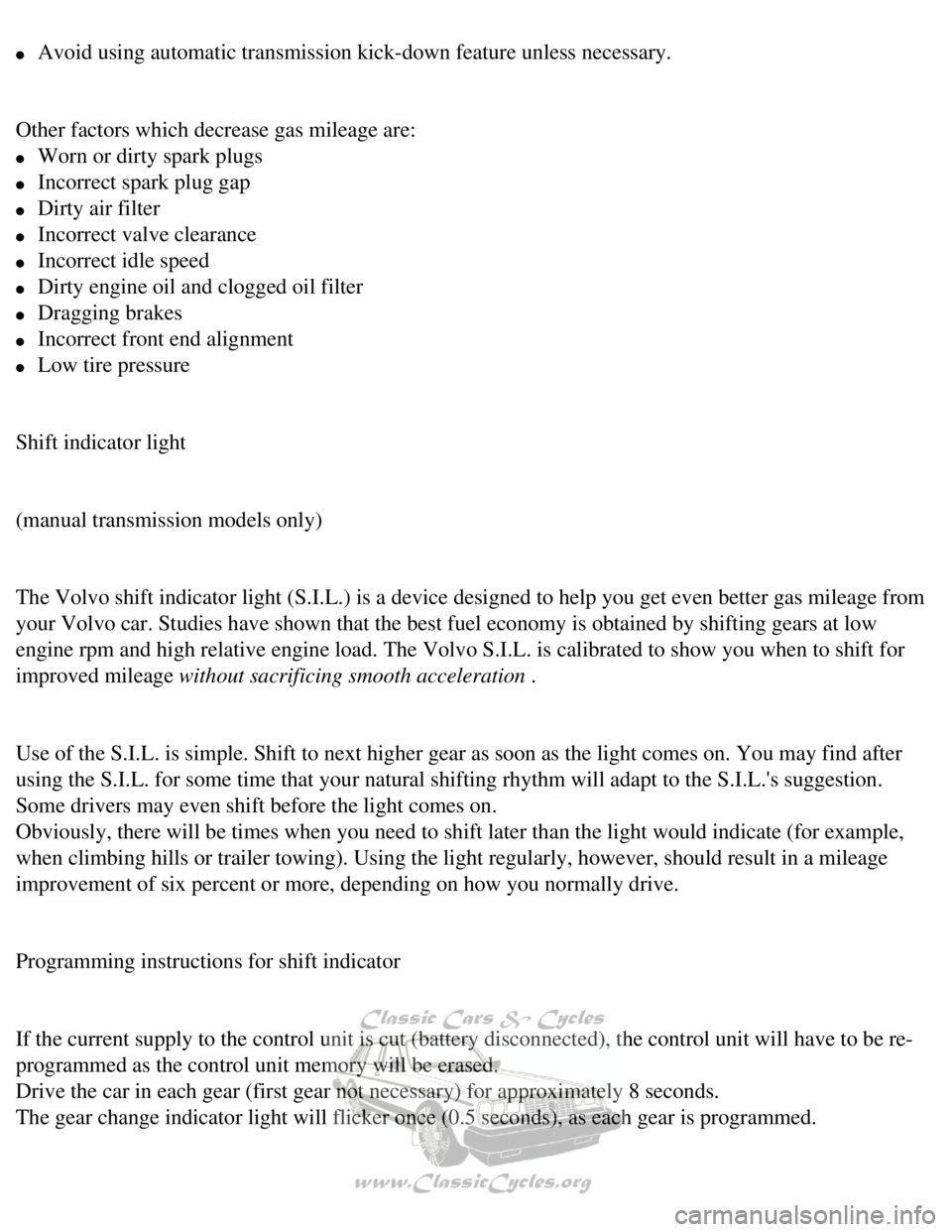
Volvo 1990 240 Model
l Avoid using automatic transmission kick-down feature unless necessary.
Other factors which decrease gas mileage are:
l Worn or dirty spark plugs
l Incorrect spark plug gap
l Dirty air filter
l Incorrect valve clearance
l Incorrect idle speed
l Dirty engine oil and clogged oil filter
l Dragging brakes
l Incorrect front end alignment
l Low tire pressure
Shift indicator light
(manual transmission models only)
The Volvo shift indicator light (S.I.L.) is a device designed to help \
you get even better gas mileage from
your Volvo car. Studies have shown that the best fuel economy is obtaine\
d by shifting gears at low
engine rpm and high relative engine load. The Volvo S.I.L. is calibrated\
to show you when to shift for
improved mileage without sacrificing smooth acceleration .
Use of the S.I.L. is simple. Shift to next higher gear as soon as the li\
ght comes on. You may find after
using the S.I.L. for some time that your natural shifting rhythm will ad\
apt to the S.I.L.'s suggestion.
Some drivers may even shift before the light comes on.
Obviously, there will be times when you need to shift later than the lig\
ht would indicate (for example,
when climbing hills or trailer towing). Using the light regularly, howe\
ver, should result in a mileage
improvement of six percent or more, depending on how you normally drive.\
Programming instructions for shift indicator
If the current supply to the control unit is cut (battery disconnected)\
, the control unit will have to be re-
programmed as the control unit memory will be erased.
Drive the car in each gear (first gear not necessary) for approximatel\
y 8 seconds.
The gear change indicator light will flicker once (0.5 seconds), as ea\
ch gear is programmed.
file:///K|/ownersdocs/1990/1990_240/90240_09.htm (4 of 6)12/30/2006 8:\
25:05 AM
Page 70 of 143
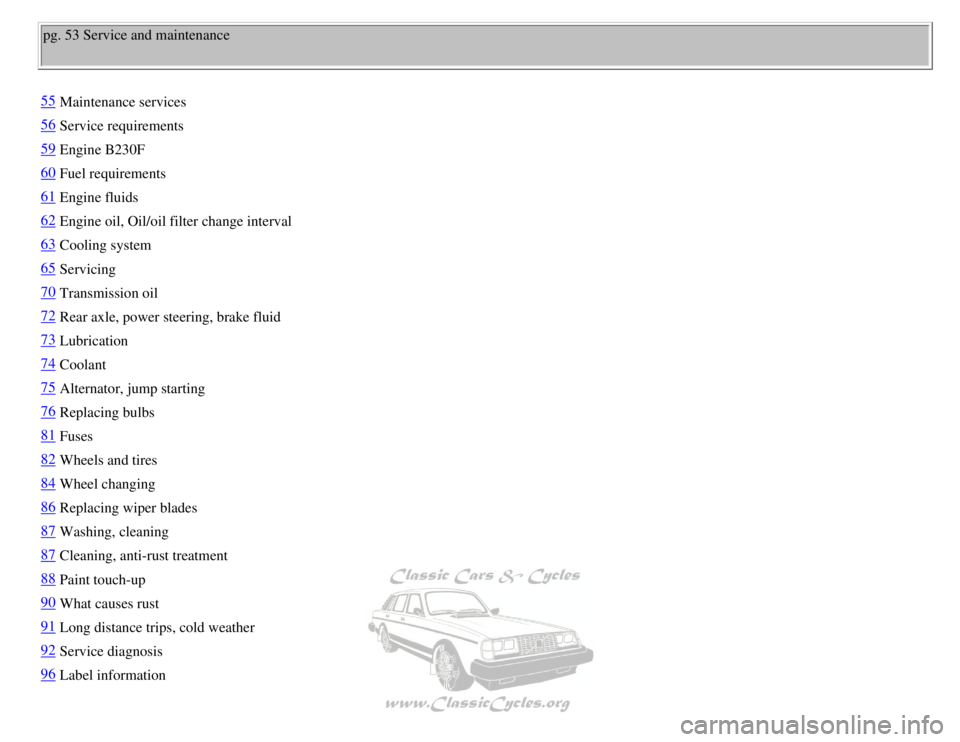
Volvo 1990 240 Model
pg. 53 Service and maintenance
55Maintenance services
56Service requirements
59Engine B230F
60Fuel requirements
61Engine fluids
62Engine oil, Oil/oil filter change interval
63Cooling system
65Servicing
70Transmission oil
72Rear axle, power steering, brake fluid
73Lubrication
74Coolant
75Alternator, jump starting
76Replacing bulbs
81Fuses
82Wheels and tires
84Wheel changing
86Replacing wiper blades
87Washing, cleaning
87Cleaning, anti-rust treatment
88Paint touch-up
90What causes rust
91Long distance trips, cold weather
92Service diagnosis
96Label information
file:///K|/ownersdocs/1990/1990_240/90240_12.htm (1 of 7)12/30/2006 8:\
25:07 AM
Page 73 of 143
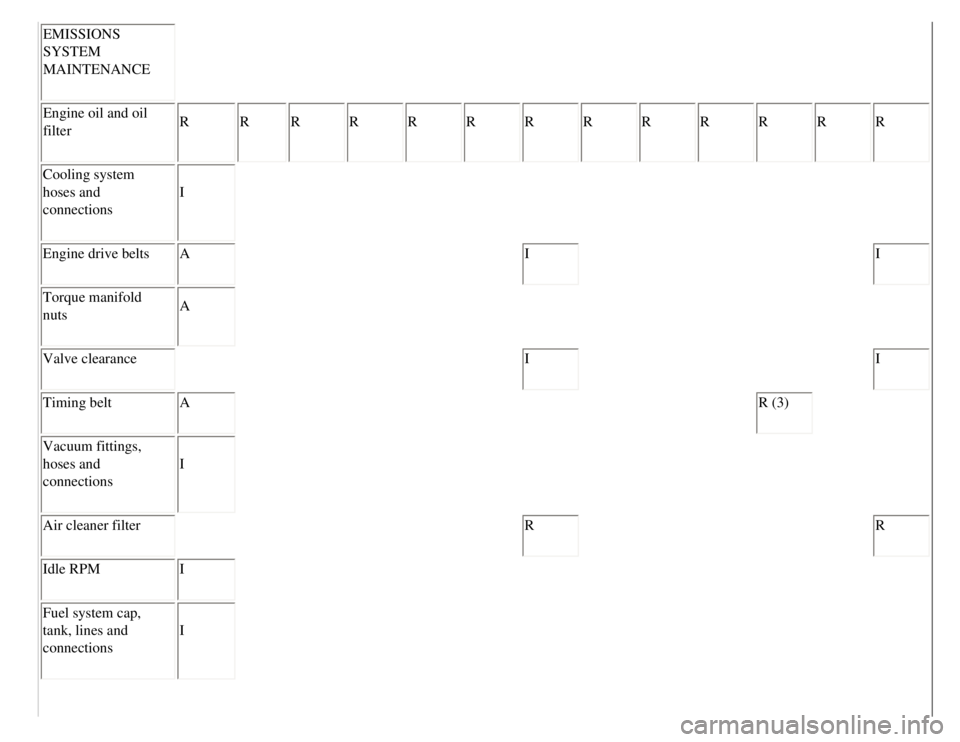
Volvo 1990 240 Model
EMISSIONS
SYSTEM
MAINTENANCE
Engine oil and oil
filter R
R R R R R R R R R R R R
Cooling system
hoses and
connections I
Engine drive belts A I I
Torque manifold
nuts A
Valve clearance I I
Timing belt A R (3)
Vacuum fittings,
hoses and
connections I
Air cleaner filter R R
Idle RPM I
Fuel system cap,
tank, lines and
connections I
file:///K|/ownersdocs/1990/1990_240/90240_12.htm (4 of 7)12/30/2006 8:\
25:07 AM
Page 75 of 143
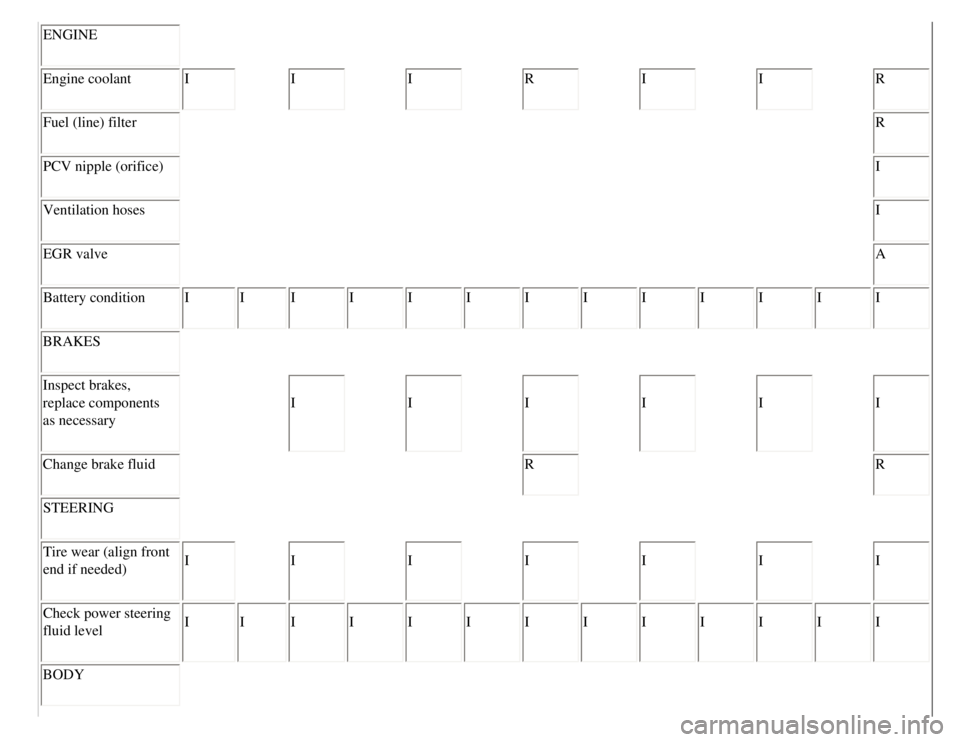
Volvo 1990 240 Model
ENGINE
Engine coolant I I I R I I R
Fuel (line) filter R
PCV nipple (orifice) I
Ventilation hoses I
EGR valve A
Battery condition I I I I I I I I I I I I I
BRAKES
Inspect brakes,
replace components
as necessary I
I I I I I
Change brake fluid R R
STEERING
Tire wear (align front
end if needed) I
I I I I I I
Check power steering
fluid level I
I I I I I I I I I I I I
BODY
file:///K|/ownersdocs/1990/1990_240/90240_12.htm (6 of 7)12/30/2006 8:\
25:07 AM
Page 78 of 143
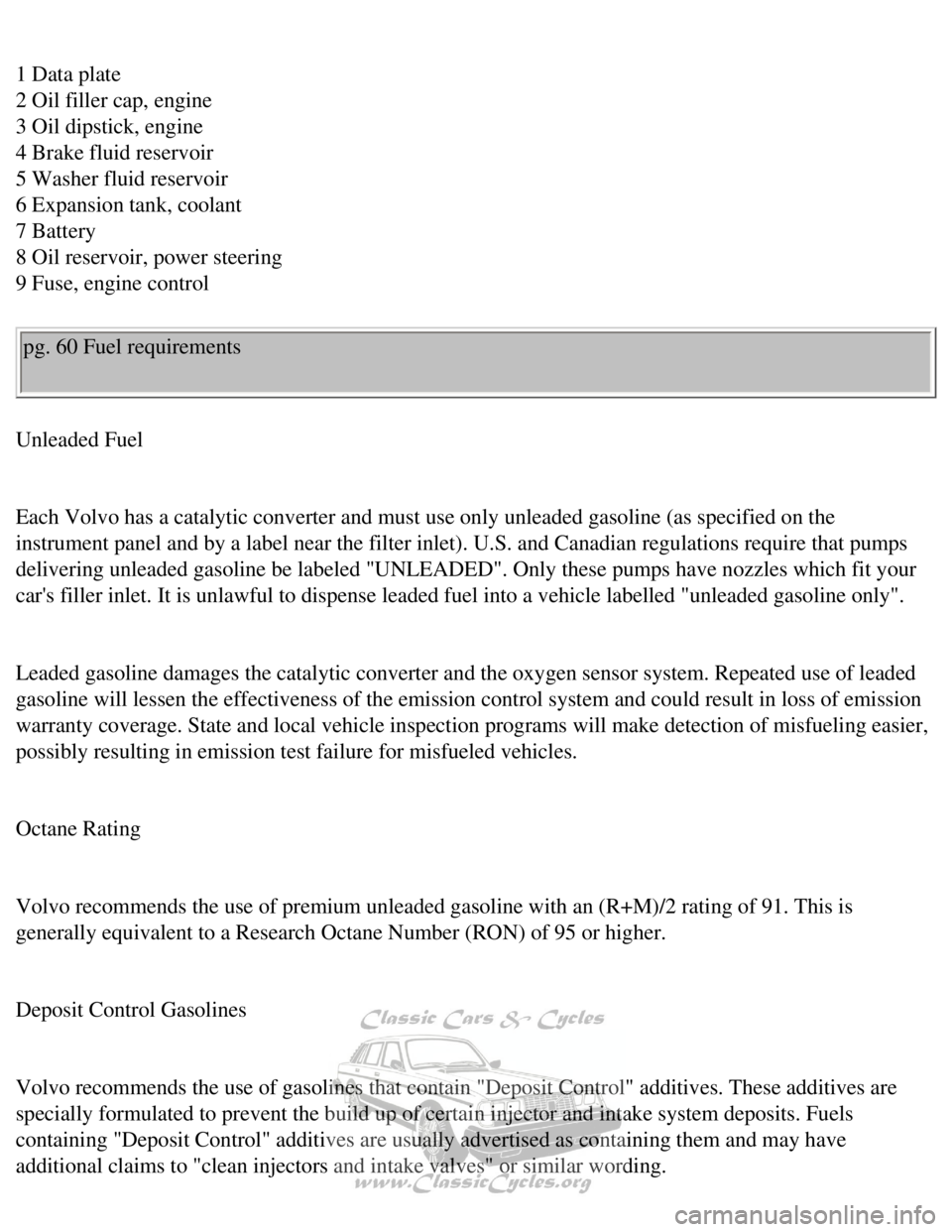
Volvo 1990 240 Model
1 Data plate
2 Oil filler cap, engine
3 Oil dipstick, engine
4 Brake fluid reservoir
5 Washer fluid reservoir
6 Expansion tank, coolant
7 Battery
8 Oil reservoir, power steering
9 Fuse, engine control pg. 60 Fuel requirements
Unleaded Fuel
Each Volvo has a catalytic converter and must use only unleaded gasoline\
(as specified on the
instrument panel and by a label near the filter inlet). U.S. and Canadi\
an regulations require that pumps
delivering unleaded gasoline be labeled "UNLEADED". Only these pumps hav\
e nozzles which fit your
car's filler inlet. It is unlawful to dispense leaded fuel into a vehicl\
e labelled "unleaded gasoline only".
Leaded gasoline damages the catalytic converter and the oxygen sensor sy\
stem. Repeated use of leaded
gasoline will lessen the effectiveness of the emission control system an\
d could result in loss of emission
warranty coverage. State and local vehicle inspection programs will make\
detection of misfueling easier,
possibly resulting in emission test failure for misfueled vehicles.
Octane Rating
Volvo recommends the use of premium unleaded gasoline with an (R+M)/2 \
rating of 91. This is
generally equivalent to a Research Octane Number (RON) of 95 or higher\
.
Deposit Control Gasolines
Volvo recommends the use of gasolines that contain "Deposit Control" add\
itives. These additives are
specially formulated to prevent the build up of certain injector and int\
ake system deposits. Fuels
containing "Deposit Control" additives are usually advertised as contain\
ing them and may have
additional claims to "clean injectors and intake valves" or similar word\
ing.
file:///K|/ownersdocs/1990/1990_240/90240_13.htm (2 of 9)12/30/2006 8:\
25:08 AM
Page 80 of 143
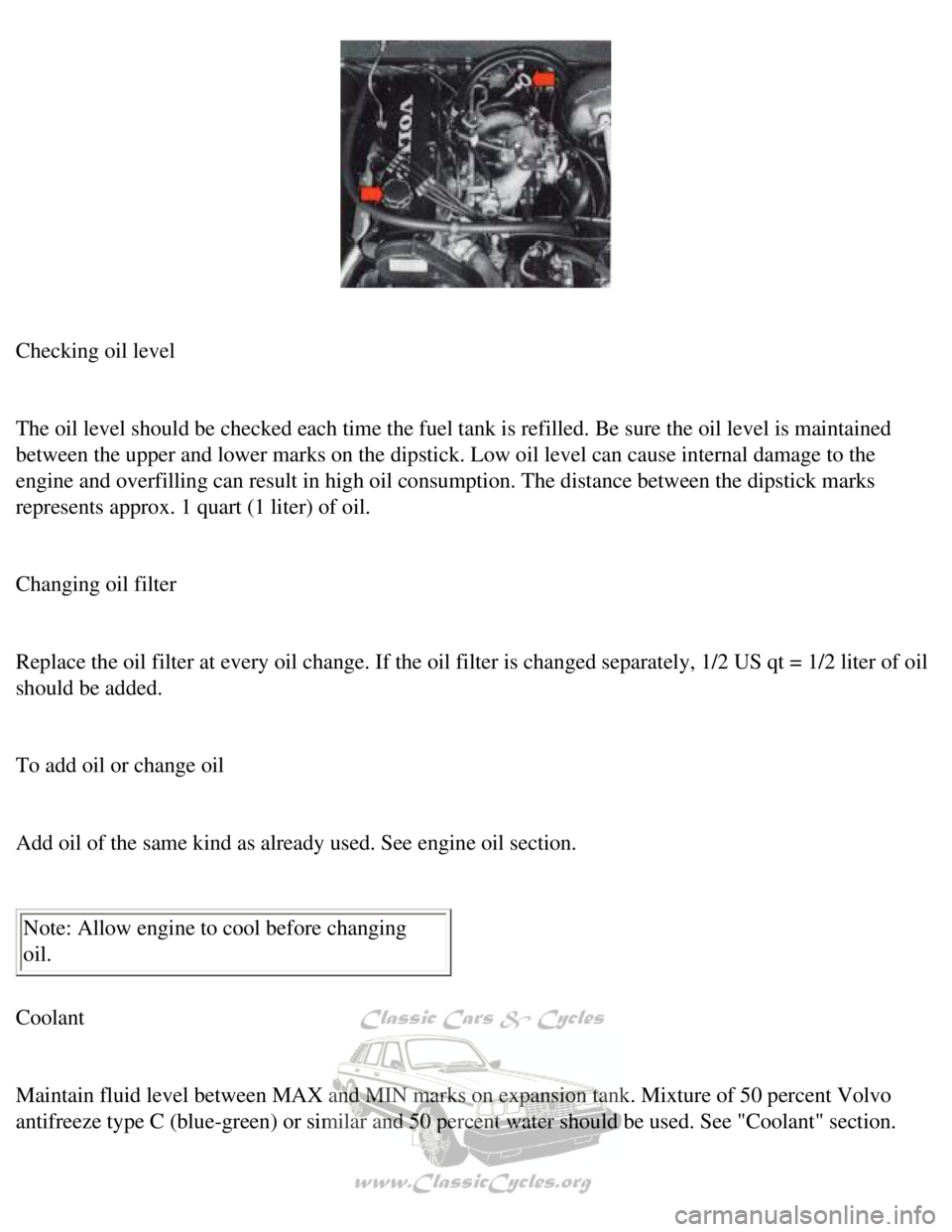
Volvo 1990 240 Model
Checking oil level
The oil level should be checked each time the fuel tank is refilled. Be \
sure the oil level is maintained
between the upper and lower marks on the dipstick. Low oil level can cau\
se internal damage to the
engine and overfilling can result in high oil consumption. The distance \
between the dipstick marks
represents approx. 1 quart (1 liter) of oil.
Changing oil filter
Replace the oil filter at every oil change. If the oil filter is changed\
separately, 1/2 US qt = 1/2 liter of oil
should be added.
To add oil or change oil
Add oil of the same kind as already used. See engine oil section.
Note: Allow engine to cool before changing
oil.
Coolant
Maintain fluid level between MAX and MIN marks on expansion tank. Mixtur\
e of 50 percent Volvo
antifreeze type C (blue-green) or similar and 50 percent water should \
be used. See "Coolant" section.
file:///K|/ownersdocs/1990/1990_240/90240_13.htm (4 of 9)12/30/2006 8:\
25:08 AM
Page 82 of 143
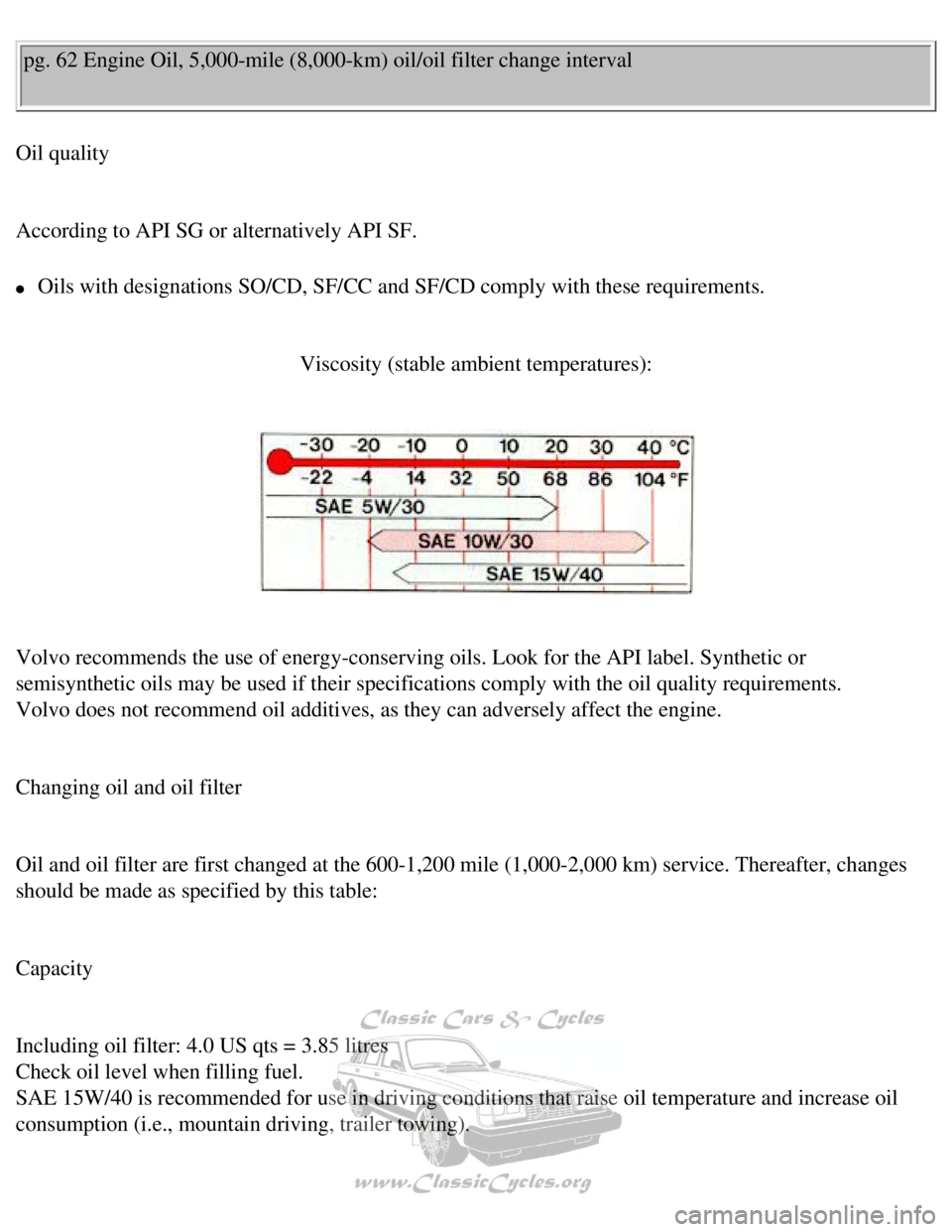
Volvo 1990 240 Model
pg. 62 Engine Oil, 5,000-mile (8,000-km) oil/oil filter change interva\
l
Oil quality
According to API SG or alternatively API SF.
l Oils with designations SO/CD, SF/CC and SF/CD comply with these requirem\
ents.
Viscosity (stable ambient temperatures):
Volvo recommends the use of energy-conserving oils. Look for the API lab\
el. Synthetic or
semisynthetic oils may be used if their specifications comply with the o\
il quality requirements.
Volvo does not recommend oil additives, as they can adversely affect the\
engine.
Changing oil and oil filter
Oil and oil filter are first changed at the 600-1,200 mile (1,000-2,000\
km) service. Thereafter, changes
should be made as specified by this table:
Capacity
Including oil filter: 4.0 US qts = 3.85 litres
Check oil level when filling fuel.
SAE 15W/40 is recommended for use in driving conditions that raise oil t\
emperature and increase oil
consumption (i.e., mountain driving, trailer towing).
file:///K|/ownersdocs/1990/1990_240/90240_13.htm (6 of 9)12/30/2006 8:\
25:08 AM
Page 87 of 143
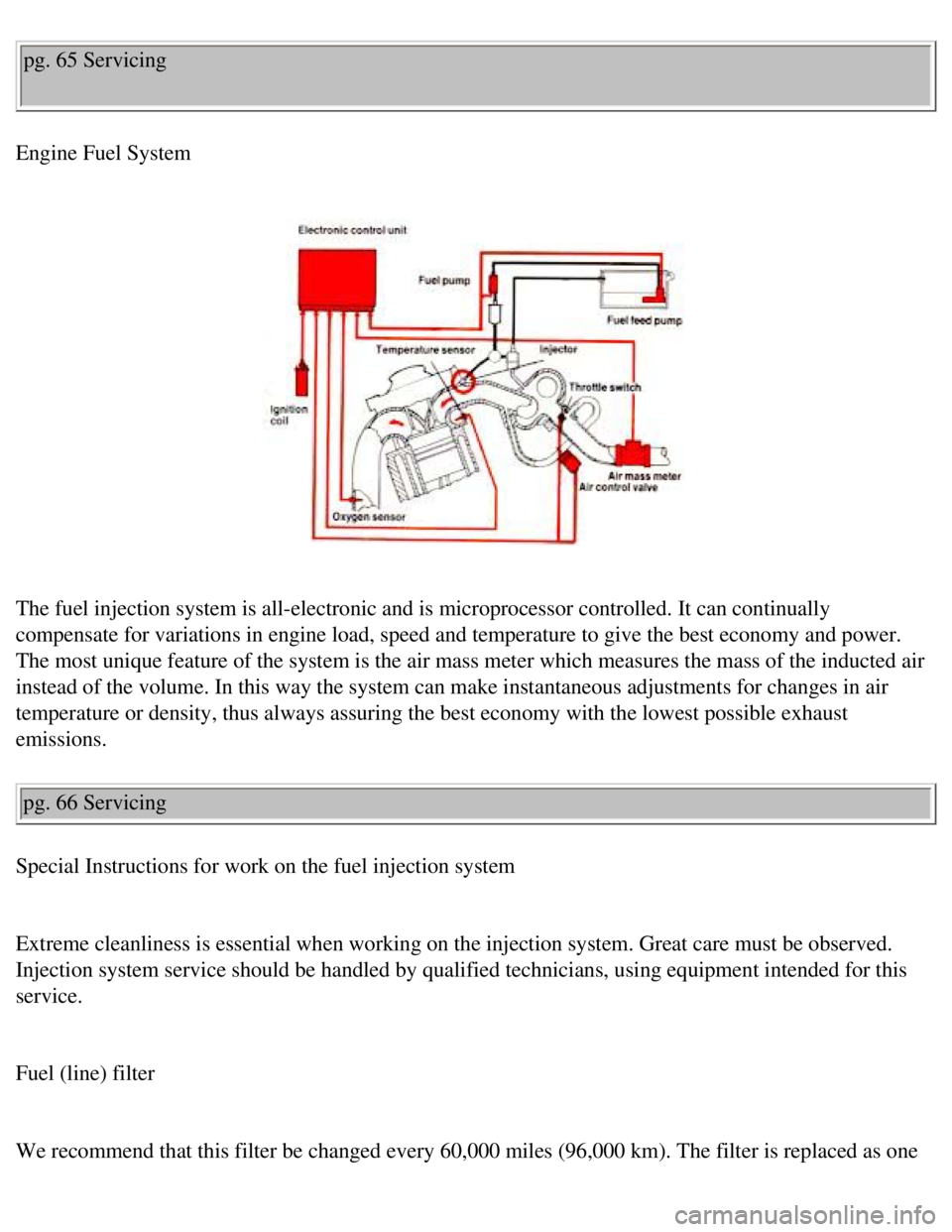
Volvo 1990 240 Model
pg. 65 Servicing
Engine Fuel System
The fuel injection system is all-electronic and is microprocessor contro\
lled. It can continually
compensate for variations in engine load, speed and temperature to give \
the best economy and power.
The most unique feature of the system is the air mass meter which measur\
es the mass of the inducted air
instead of the volume. In this way the system can make instantaneous adj\
ustments for changes in air
temperature or density, thus always assuring the best economy with the l\
owest possible exhaust
emissions. pg. 66 Servicing
Special Instructions for work on the fuel injection system
Extreme cleanliness is essential when working on the injection system. G\
reat care must be observed.
Injection system service should be handled by qualified technicians, usi\
ng equipment intended for this
service.
Fuel (line) filter
We recommend that this filter be changed every 60,000 miles (96,000 km)\
. The filter is replaced as one
file:///K|/ownersdocs/1990/1990_240/90240_14.htm (2 of 7)12/30/2006 8:\
25:08 AM
Page 88 of 143
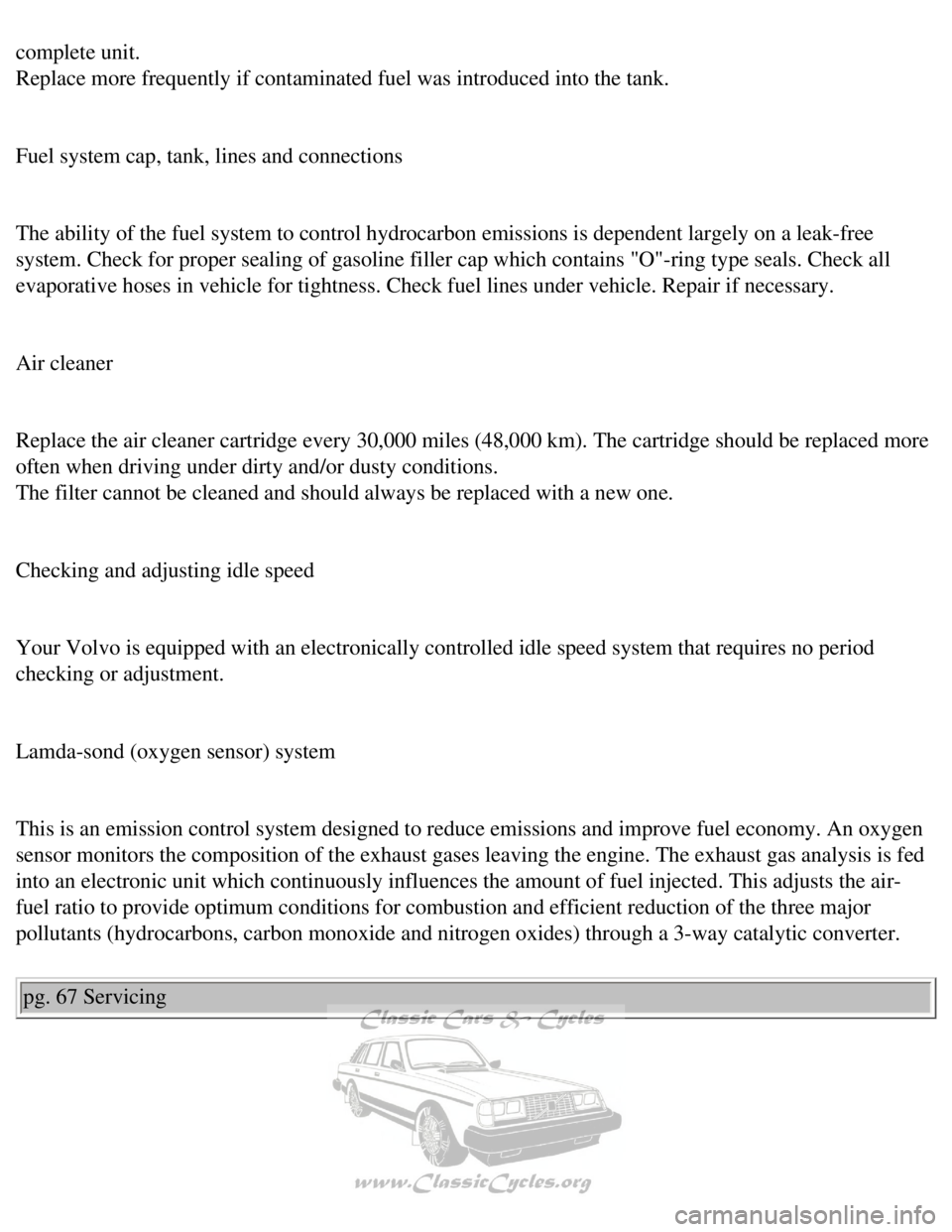
Volvo 1990 240 Model
complete unit.
Replace more frequently if contaminated fuel was introduced into the tan\
k.
Fuel system cap, tank, lines and connections
The ability of the fuel system to control hydrocarbon emissions is depen\
dent largely on a leak-free
system. Check for proper sealing of gasoline filler cap which contains "\
O"-ring type seals. Check all
evaporative hoses in vehicle for tightness. Check fuel lines under vehic\
le. Repair if necessary.
Air cleaner
Replace the air cleaner cartridge every 30,000 miles (48,000 km). The \
cartridge should be replaced more
often when driving under dirty and/or dusty conditions.
The filter cannot be cleaned and should always be replaced with a new on\
e.
Checking and adjusting idle speed
Your Volvo is equipped with an electronically controlled idle speed syst\
em that requires no period
checking or adjustment.
Lamda-sond (oxygen sensor) system
This is an emission control system designed to reduce emissions and impr\
ove fuel economy. An oxygen
sensor monitors the composition of the exhaust gases leaving the engine.\
The exhaust gas analysis is fed
into an electronic unit which continuously influences the amount of fuel\
injected. This adjusts the air-
fuel ratio to provide optimum conditions for combustion and efficient re\
duction of the three major
pollutants (hydrocarbons, carbon monoxide and nitrogen oxides) through\
a 3-way catalytic converter. pg. 67 Servicing
file:///K|/ownersdocs/1990/1990_240/90240_14.htm (3 of 7)12/30/2006 8:\
25:08 AM
Page 91 of 143
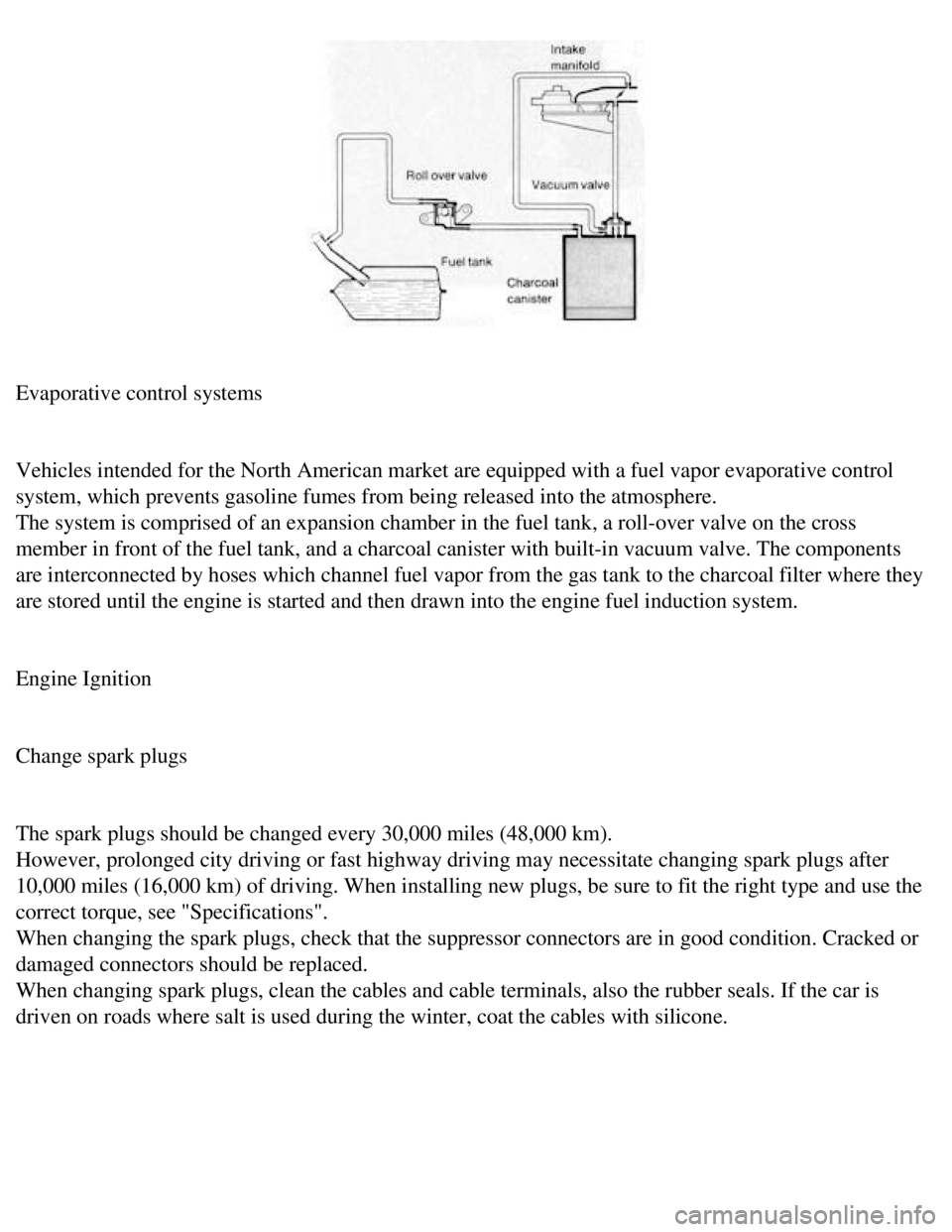
Volvo 1990 240 Model
Evaporative control systems
Vehicles intended for the North American market are equipped with a fuel\
vapor evaporative control
system, which prevents gasoline fumes from being released into the atmos\
phere.
The system is comprised of an expansion chamber in the fuel tank, a roll\
-over valve on the cross
member in front of the fuel tank, and a charcoal canister with built-in \
vacuum valve. The components
are interconnected by hoses which channel fuel vapor from the gas tank t\
o the charcoal filter where they
are stored until the engine is started and then drawn into the engine fu\
el induction system.
Engine Ignition
Change spark plugs
The spark plugs should be changed every 30,000 miles (48,000 km).
However, prolonged city driving or fast highway driving may necessitate \
changing spark plugs after
10,000 miles (16,000 km) of driving. When installing new plugs, be sur\
e to fit the right type and use the
correct torque, see "Specifications".
When changing the spark plugs, check that the suppressor connectors are \
in good condition. Cracked or
damaged connectors should be replaced.
When changing spark plugs, clean the cables and cable terminals, also th\
e rubber seals. If the car is
driven on roads where salt is used during the winter, coat the cables wi\
th silicone.
file:///K|/ownersdocs/1990/1990_240/90240_14.htm (6 of 7)12/30/2006 8:\
25:08 AM